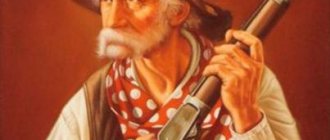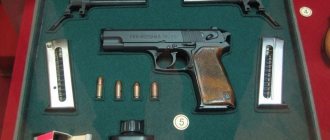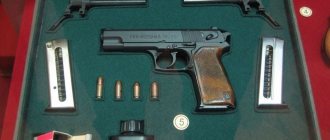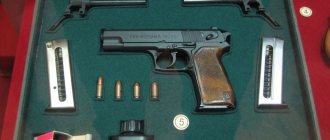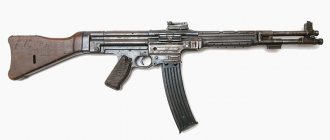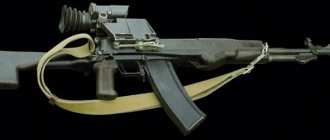| .44-40 | |
| Characteristics: | |
| |
| Manufacturer country: | USA USA |
| Cartridge type: | pistol cartridge, rifle cartridge |
| Production history: | |
| Constructor: | Winchester Repeating Arms Company |
| Time of creation: | 1873 |
| Current bullet caliber: | 10,8 |
| Sleeve length: | 33,3 |
| Sleeve flange diameter, : | 13,3 |
| Case neck diameter, : | 11,3 |
| Sleeve base diameter, : | 12,0 |
| Case shoulder diameter, : | 11,6 |
| Bullet weight: | 13 |
| Initial bullet speed, m/s: | 379 |
| Bullet energy: | 933 |
The .44-40 Winchester
also known as
.44 Winchester
,
.44 WCF
(Winchester Center Fire),
10.5x34mm
,
.44 Largo
(in Spanish-speaking countries) was introduced by the Winchester Repeating Arms Company in 1873 as the first all-metal centerfire cartridge in its assortment. Together with the Winchester Model 1873 rifle, it quickly gained wide popularity not only as a rifle ammunition, but also as a revolver ammunition, for example, the Colt Single Action Army. In addition, it was used in small arms from Remington Arms and Marlin Firearms. Due to the emergence of new types of smokeless powder, production of the .44-40 Winchester cartridge was discontinued in 1937.
An excerpt characterizing the .44-40 Winchester
– But do you know how it all ended? Have you heard about the duel? - Yes, you went through that too. “The one thing I thank God for is that I didn’t kill this man,” said Pierre. - From what? - said Prince Andrei. – It’s even very good to kill an angry dog. - No, killing a person is not good, it’s unfair... - Why is it unfair? - repeated Prince Andrei; what is just and unjust is not given to people to judge. People have always been mistaken and will continue to be mistaken, and in nothing more than in what they consider just and unjust. “It is unfair that there is evil for another person,” said Pierre, feeling with pleasure that for the first time since his arrival, Prince Andrei became animated and began to speak and wanted to express everything that made him what he was now. – Who told you what evil is for another person? - he asked. - Evil? Evil? - said Pierre, - we all know what evil is for ourselves. “Yes, we know, but the evil that I know for myself, I cannot do to another person,” Prince Andrei said more and more animatedly, apparently wanting to express to Pierre his new view of things. He spoke French. Je ne connais l dans la vie que deux maux bien reels: c'est le remord et la maladie. II n'est de bien que l'absence de ces maux. [I know only two real misfortunes in life: remorse and illness. And the only good is the absence of these evils.] To live for yourself, avoiding only these two evils: that is all my wisdom now. – What about love for one’s neighbor, and self-sacrifice? - Pierre spoke. - No, I cannot agree with you! To live only in such a way as not to do evil, so as not to repent? this is not enough. I lived like this, I lived for myself and ruined my life. And only now, when I live, at least try (Pierre corrected himself out of modesty) to live for others, only now I understand all the happiness of life. No, I don’t agree with you, and you don’t mean what you say.
A ballad about the famous Winchester: new cartridges, new weapons...
Little Bighorn River Valley, Montana County
Sunday, June 25, 1876 1:00 pm An arrow pierced his left eye, the feathered shaft went deep into his head, his back jerked, arched back, his arms spread wide to the sides, and his horse reared, throwing the soldier from the saddle onto the ground, so that his bones crunched, right under the feet of Lieutenant Colonel George Armstrong Custer.
- Where the hell is Reno? Custer yelled amid the growing noise of the battle, turning and firing his Webley at the Cheyenne rushing towards him. The shot was successful.
The Colonel stood at the crest of a hill north of Medicine Tail Kuuli, his yellowish hair cut short, his unshaven cheekbones covered with ingrained dust from three days of riding in the wild region. Dust covered his sideburns, his breeches tucked into his blunt-toed cavalry boots, and the sweat-stained red handkerchief tied around his neck. His once white, wide-brimmed hat, which had fallen in the heat of battle, now lay trampled in the sage at his feet.
The one who died today was the skilled, well-trained cavalryman who led the Seventh to victory in 1868, when, breaking out of a raging storm, they destroyed Black Kettle's camp on the banks of the Washita River.
Finding himself in the place of the man who previously had a reputation as the best Indian pacifier in the US Army, he was a tired, unkempt soldier, desperately fighting for his life, shouting commands to the young bugler standing next to him.
- Denser, damn you, denser!
– In the name of God, guys, don’t run! What is this? Defeat?
“Let Kelhoun's men dismount and turn around like foot soldiers!”
Sergeant Robert Hughes of Company K held Custer's battle flag.
A fluttering banner with red and blue stripes and two crossed sabers indicated by its presence that the colonel was on the battlefield. As Custer opened his Webley to load it with .45-caliber ammunition from the bandoleer on his belt, Hughes shouted:
- Dear Jesus! Tom got his!
Captain Tom Custer, the colonel's brother, having received a blow between the eyes, splashed blood and brains all over the frightened standard-bearer.
- They're coming here! - the bugler shouted. - Black as devils, and full of them, like grass! Oh God, we're going to die!
Custer's view of the Indian settlement stretching along the river from a high cliff, later known as Battle Crest, was limited to thickets of tall, dry grass. As he looked down at the incredible carnage going on below, he realized that there were far more inhabitants than he had expected. Unknown to the Colonel, the Sioux and Cheyenne were arranged in seven rings, four miles long, formed when three allied tribes—each following its own hunting trail, as was clear from their size—joined together shortly before the cavalry charge.
Custer was an arrogant man of exorbitant ambition. A commander for whom attack and victory were synonymous. Retreating from the battlefield was simply not in his rules. Three days ago, his rangers had discovered a fresh hunting trail, and he then ordered the Seventh Regiment to follow it through the sun-scorched Wolf Mountains to the place where the Indians were camped. His plan was to take them by surprise with a surprise cavalry attack from two sides, and to do this he divided his 615 soldiers into three battalions. Having personally led the lead force while Reno's column was to attack in flank, the colonel galloped his battalion towards the camp, where not only the Indians they were pursuing were found, but also warriors of other allied tribes. His people were outnumbered by one in ten. Custer's luck had turned against him.
Like bees flying out of a hive, the Sioux and Cheyenne launched a furious counterattack. Furious Sioux, such as the Black Moon, the Raven King and Gal the Furious Warrior, half-dressed, rushed from their tipis [1] to the line of soldiers armed with long sabers; Some of them wore the fighting headdresses of the plains tribes, others had feathers in their hair, tied up in a bun, signifying "cut throats and scalps," or parted, indicating that the wearer had "suffered many wounds." Cheyenne braves like Dull Knife, Flat Thigh, and Ice Bear screamed wildly to force the enemy to retreat, some firing Winchesters, others with older muzzleloaders; some were armed with bows and arrows or long feathered spears, while others brandished double-edged tomahawks. The Crazy Horses, Ogalala Sioux—their horses adorned with severed toes to boast the number of enemy kills—galloped after Custer and his discarded men, scattering the whites down the slope.
Caliber History: .44 Magnum
"Forty-four" - a mighty American and his Russian grandfather
Robert Marlboro: “You know, every bullet and every shot from this gun costs $2.”
Harley Davidson: How many have I shot so far? Robert Marlborough: “12 bucks, but the result is zero.
And I shot one and spent 4.25 on it.” film "Harley Davidson and the Marlboro Man" 1991
According to the plot of the film, Harley Davidson shoots a pistol, which he himself called the “Desert Eagle 44 Magnum. 6 in the magazine, one in the barrel." In fact, the film starred the Desert Eagle MK VII in .357 Magnum caliber - also an interesting cartridge that we will definitely tell you about. But now we are interested in “forty-four” - a thunderstorm of villains in black cloaks and grizzly bears.
It all started back in the 19th century, when a Russian military agent, as it was commonly said then, Major General Alexander Pavlovich Gorlov, became interested in revolvers. Prior to this, Gorlov had already contributed to the appearance of the Berdan rifle and the Gatling gun in the Russian army, so Smith & Wesson could well appreciate the bright prospects opening up to them. Moreover, the Russians needed a lot of revolvers, and organizing the production of such a complex design would have been even more difficult than in the case of a rifle.
Gorlov’s interest was aroused by the Smith & Wesson Model 3. For those years it was a very successful model, one of the variants of which has already been described on our website. But if Gorlov and his colleagues liked the revolver, then its standard cartridge raised reasonable doubts among them. At that time, Smith & Wesson used the .44 S&W cartridge, similar in design to modern .22LRs - with a lead bullet whose diameter was larger than the cartridge case. When concluding the contract, one of the conditions of the Russian side was the use of a new cartridge - in the same .44 caliber, but with a bullet of reduced diameter and with the introduction of an internal lubrication system instead of the previously used external one. The bullet weight was also increased. However, now the new cartridge had too high operating pressure when fired, and in order to avoid problems with revolvers chambered for the old cartridges, S&W also had to lengthen the cartridge case slightly. The resulting .44 S&W Russian, as the Americans themselves write, became one of the milestones in the evolution of revolver cartridges and the revolvers themselves. The accuracy was especially impressive - with revolvers chambered for the “Russian” cartridge, groups of 3 inches (76 mm) were achieved at a distance of 50 yards (46 m). In general, as the same Americans write: “.44 Russian is one of the most important revolver developments since the times when we moved from round bullets, gunpowder and primers to cartridge cases.”
But time passed, and if in the days of black powder the “forty-fourth Russian” was magnificent, then with the transition to smokeless powder most of the advantage was lost. However, the dream of an accurate and powerful revolver cartridge continued to excite ammunition developers. In 1907, Smith & Wesson attempted to continue the successful history by adapting the .44 for smokeless powder by lengthening the case. The new .44 Special actually turned out to be quite accurate for a revolver cartridge, but even for the beginning of the 20th century, in terms of muzzle energy, it already looked average.
Several more years passed before a man who was a living legend in his own right became interested in the once legendary 44. Elmer Merrifield Keith, Idaho farmer, hunter, writer, shooter, and creator of magnums.
Back in the 20s, he began experimenting with the .44 Special cartridge, gradually increasing the bullet weight and powder charge. But only in 1955 these experiments led to the creation of the next “forty-four”. Meet their majesty .44 Magnum. “The bullet speed is four hundred meters, we have two thousand joules at the muzzle”
.
A serial cartridge, based on Keith’s work, was created at , and the first weapon for it was the Smith & Wesson Model 29, which at that time was the most powerful short-barreled gun in the world. But the Smith & Wesson monopoly did not last long this time - a few months later it was broken by the Ruger Blackhawk revolver. According to legend, one of the employees of Sturm, Ruger & Co discovered three unfamiliar cartridges in a landfill; after studying them, the company came to the conclusion that competitors from Smith & Wesson were preparing to release a new powerful revolver. A less beautiful version of the legend says that the cartridges, along with technical information, were given to Bill Ruger by a dishonest Remington employee.
In any case, ordinary users only benefited from the appearance of two models on the market and the availability of choice. Later, others were added to them - not only short-barreled models, but also carbines. Although formally the .44 Magnum is a revolver bullet, in some variants its muzzle energy is quite comparable to a 7.62x39 mm bullet from a Kalashnikov assault rifle.
However, at first the .44 Mag did not cause much excitement with its appearance. For service weapons or self-defense, it was, as they say, too much. But it was purchased with pleasure by hunters or fans of sports shooting from a revolver. The .44 Mag's combination of accuracy and power was impressive. The same Elmer Keith once “picked up” a deer wounded by another hunter at a distance of 548 m. Perhaps this is an achievement from the category of “hunting stories,” but the groups of 2-3 inches regularly collected from the “forty-four” at 45 meters are very real facts.
And then came 1971 and Clint Eastwood appeared on cinema screens with his S&W 29 in the movie Dirty Harry. Almost immediately after its release, the film became a cult classic, and with it, .44 revolvers.
“This is a .44 Magnum, the most powerful revolver in the world and it will blow your head off.”
Many people wanted to imagine themselves as courageous and strong as the hero of this picture, and the easiest way to do this was to buy “a gun as cool as this guy.”
Over time, of course, the hype subsided, and today most weapons under .44 Mag are produced for those for whom Elmer Keith created them - hunters and sportsmen. At least, in the statistics collected over 20 years by one corrosive American, it was this caliber that most often appeared in cases of self-defense... from bears. And each time it was not the bear that became the winner.
